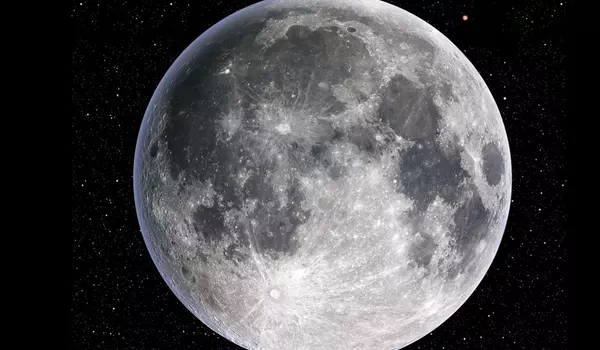A sophisticated analysis of a rock sample collected from the Moon during the Apollo 17 mission revealed new details about the Moon’s complex cooling and evolutionary history. The diffusion patterns preserved in the mineral grains were consistent with a rapid cooling history at high temperatures lasting no more than 20 million years. The discovery contradicts previous estimates of a cooling duration of 100 million years and supports initial rapid cooling of magmas within the lunar crust.
The Moon was most likely formed as a massive ball of magma from the remains of an impact on Earth about four and a half billion years ago. After the hot material cooled and formed a sphere, the magma began to cool, eventually forming a crust on the Moon’s surface with the magma just beneath.
A massive impact blasted the Moon’s south pole around 4.3 billion years ago, forming the South Pole-Aitken Basin and sending debris as far as the opposite side of the Moon. This impact signaled the start of a period that would result in large-scale changes to the Moon’s surface. More massive collisions shaped the terrain one by one, with some forming large basins that would eventually fill in to form the dark colored patches of the Moon known as maria. They started out as normal craters but quickly changed due to the size of the impact on the relatively thin crust.
Surprisingly, we discovered chemical variations within olivine and plagioclase crystals. These heterogeneities allow us to use numerical models to constrain the earliest, high-temperature cooling histories of these minerals.
William Nelson
A sophisticated analysis of a rock sample collected from the Moon during the Apollo 17 mission revealed new details about the Moon’s complex cooling and evolutionary history. The findings were published in Nature Communications by researchers at the University of Hawai’i at Manoa.
The rock sample troctolite 76535 was collected from the Moon’s surface by Apollo 17 astronauts in 1972, and it remains one of the most scientifically valuable samples of the Moon due to its pristine nature. Furthermore, the rock type is common on the Moon and is likely to contain important clues to lunar formation.
The study’s lead author, William Nelson, an Earth Sciences graduate student at UH Manoa’s School of Ocean and Earth Science and Technology (SOEST), and co-authors used a specialized electron microprobe to conduct high-resolution analysis of troctolite 76535.
“Previous reports indicate that the minerals in the Apollo 17 sample were chemically homogeneous,” Nelson stated. “Surprisingly, we discovered chemical variations within olivine and plagioclase crystals. These heterogeneities allow us to use numerical models to constrain the earliest, high-temperature cooling histories of these minerals.”

SOEST researchers used the University of Hawaii’s High-Performance Computing facilities, Mana, to examine the effects of a variety of computer-simulated cooling paths, totaling well over 5 million chemical diffusion models. “The simulations revealed that these heterogeneities could only survive at high temperatures for a relatively short period of time,” Nelson said.
The diffusion patterns preserved in the mineral grains and observed with the microprobe were consistent with a rapid cooling history at high temperatures of no more than 20 million years. The discovery contradicts previous estimates of a cooling duration of 100 million years and supports initial rapid cooling of magmas within the lunar crust.
“This is changing our outlook on how an important suite of lunar rocks formed,” said Nelson.
To reconcile high-temperature cooling rates with the generally accepted view of how these rocks formed, the research team proposed that this rock type may be formed by a process known as reactive infiltration, in which a melt interacts with rock, changing its chemical and physical makeup.
The study also shows the importance of re-examining previously analyzed samples with modern techniques, as well as how quickly new data can reshape our understanding of planetary evolution.
Finally, we arrive at the Moon that we see today. Though the surface is still being affected by impacts, the rate has slowed dramatically to the point where the Moon appears unchanged to the human eye as a permanent record of its own history and a glimpse of how craters may have formed on Earth.
To better understand the observed chemical heterogeneity, the research team is currently investigating how quickly phosphorus can diffuse in olivine crystals. In addition, they are looking for similar heterogeneities in other Apollo samples.
















